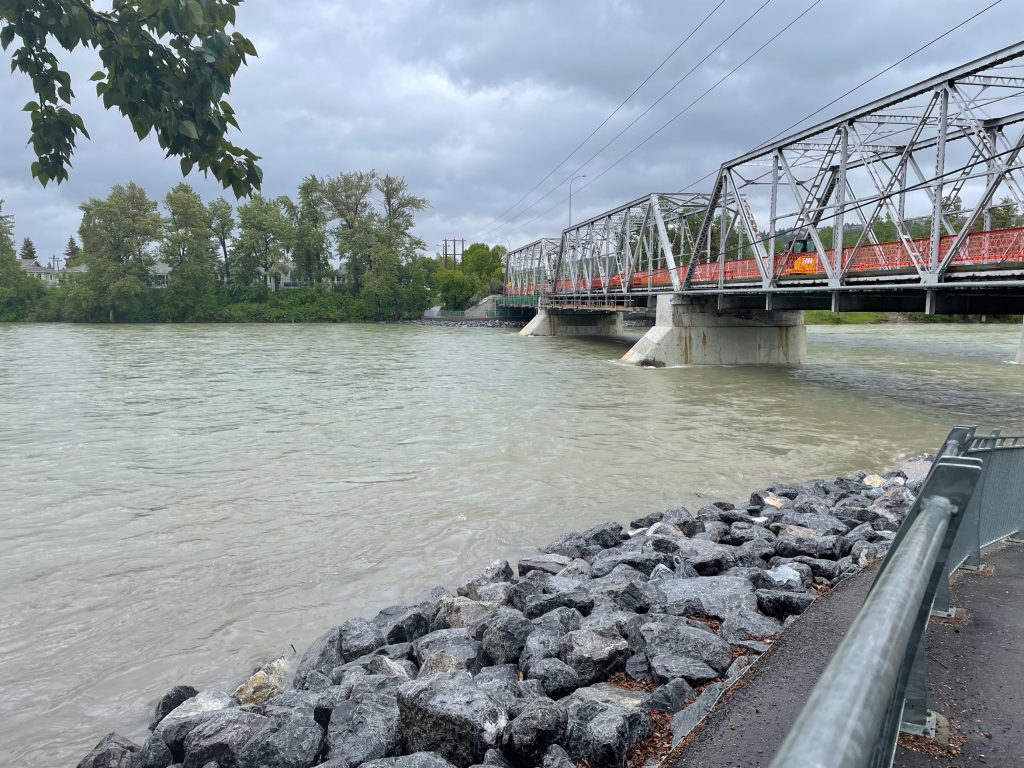Calgary declares state of local emergency over rainfall, possible flooding

Posted Jun 13, 2022 4:22 pm.
Last Updated Jun 14, 2022 1:33 pm.
Calgary has declared a state of local emergency amid heavy rainfall and the possibility of flooding.
Mayor Jyoti Gondek says this will help emergency services, should there be a need for evacuations, though she doesn’t foresee that being required at the moment.
“Over the last 24 hours, forecast conditions in the Kananaskis region and Calgary have not improved, with potential for more severe weather than originally anticipated. At this point, river flows are not expected to cause widespread overbank flooding, however, there will be impacted communities,” Gondek said at a briefing Monday afternoon.
“I realize that may cause some fear, some anxiety for Calgarians, especially those who went through this in 2013. I can tell you that you’re in good hands.”
The declaration is in place for 14 days and can be rescinded or renewed, Gondek notes.
“The other thing that we have the ability to do (under the state of local emergency) is allow our experts in the water services team to access property, as needed, to protect critical infrastructure. It also offers purchasing flexibility to members of administration, as needed, if we get into more severe weather,” the mayor explained.
While the 2013 floods may be top of mind for many locals, Gondek stresses current river levels are well below what the region saw back then, adding the local state of emergency is being called “out of extreme caution.”
In an update to Calgary City Council on Tuesday morning, Calgary Emergency Management Agency Chief Sue Henry says it appears the situation is improving, but concerns remain.
“We still have a lot of work to do, but the forecast is looking a little bit better, particularly for areas along the Bow River,” Henry said. “We are still expecting to see heavy rain [Tuesday] until about [2 p.m. MT] where we could see 25 to 35 millimetres of rain still to come, which is why I say this is not over for us yet and there is still a significant amount of risk.”
Calgary neighbourhoods told to prepare for rising waters
There were some precautionary evacuations carried out on Monday night for homes that were at risk around McHugh Bluff. The area was closed off due to erosion and a failing retaining wall.
A rainfall warning for the city and river watch for the Bow and Elbow rivers remain in effect, with Environment Canada expecting between 75 to 125 millimetres of rain by Wednesday morning.
Henry adds because of extensive flood mitigation work done since 2013, Calgary is not expecting overland flooding on the Elbow River, but is unsure about the Bow River. She says communities along the rivers should be prepared for any evacuation alerts at a moment’s notice.
The most at-risk areas for flooding in the city are along the Bow River in Bowness, along Memorial Drive near Prince’s Island, along Deerfoot Trail between the Calf Robe Bridge and Glenmore Trail, and then between Southland Drive and Anderson Road.

Temporary berm construction on Memorial Drive. (Nick Blakeney, CityNews Photo)
“You will notice there is a closure on Memorial Drive, and that is for the temporary berm construction that is occurring on Memorial Drive. Citizens will also notice preparedness activities in some of the low lying areas, this is things like pumps and some work around the outfall stations,” Henry said.
The Memorial Drive closure runs from Edmonton Trail to 10 Street NW.
While high water levels are not expected until Wednesday, there may be a need to be on standby to evacuate in some localized communities along the Bow River. There are no calls for evacuation at this time.
View the map of potentially affected areas at https://t.co/Qifrmgr0Ng. pic.twitter.com/uAbQxZZXh8
— City of Calgary (@cityofcalgary) June 14, 2022
Alberta government ready to assist
The province has also announced it is ready to support the community and others, as needed.
“While I realize having a flood warning or flood watch in place will be especially difficult for folks in Calgary, High River, Canmore, and other communities flooded in 2013, please know Alberta is better prepared than ever for high river events,” Environment Minister Jason Nixon said at the update Monday.
Nixon says there has been more than 1,500 kilometres of new and updated flood mapping done since 2020, adding the province is ready to help assist communities as needed.
He notes while much flood mitigation work has been done since the devastating events of 2013, some projects remain ongoing.
“There’s been hundreds and hundreds of millions invested in flood mitigation since 2013 took place and bigger things unfortunately that aren’t quite complete yet but are in progress, including the Springbank Dam that was just recently announced. So, exactly how much Calgary can still be impacted — or other communities that have had mitigation done — is unknown until we go through these moments,” Nixon explained.
Read more:
-
Calgary rainfall warning, river watch issued
-
Banff issues flood warning for Bow River due to heavy rain
The agency warns of “prolonged and significant rainfall” over the next couple of days. CityNews Meteorologist Michael Kuss notes the duration of this weather maker is something to take note of.
“What makes this low, this system, this rainmaker so significant is not the intensity of rain coming at any specific time. It’s the duration. The low is a very slow mover, pumps up out of Nebraska, gets up into Saskatchewan and Manitoba, and we get into those rain bands around Calgary and across a good chunk of central and western Alberta over the next 48 to 72 hours,” he said Monday morning.
Listen live for weather updates after traffic every 10 minutes on the ones. You can also follow us on Twitter @CityNews660 or subscribe to breaking news alerts sent directly to your inbox.
–With files from Tom Ross










